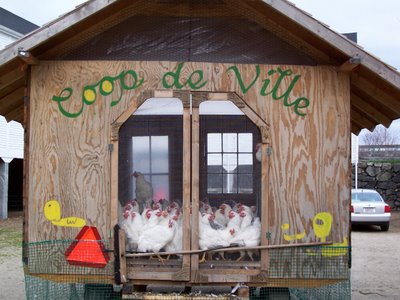 In order to avoid some Christmas shopping I needed to do today, I decided my dog Kahlil needed exercise. So I walked him down the lane next to the cow pasture at Codman Farm. The pasture is full of "normal" cows and this one little water buffalo steer named Herman. I'd met Herman before when I had to go into the pasture for the White Rock broiler chicken project. Cows scare me a bit. They are big. Some Holsteins look as big as minivans. I once climbed into the chicken tractor because I thought a young curious bull had come too close. I wouldn't leave until someone else came into the pasture to escort me out. I knew that bull could tell I was afraid. People came and went and he never bothered them, but he made me nervous. I was kind of glad when he moved on to where ever bulls go when the get older, the auction, the freezer, I don't really know, just some place where at least he won't frighten me. Herman is different. He's not intimidating. He's very friendly. He likes people. He likes attention. I'm not at all afraid of him. He's from a breed that produces buffalo mozzarella.
In order to avoid some Christmas shopping I needed to do today, I decided my dog Kahlil needed exercise. So I walked him down the lane next to the cow pasture at Codman Farm. The pasture is full of "normal" cows and this one little water buffalo steer named Herman. I'd met Herman before when I had to go into the pasture for the White Rock broiler chicken project. Cows scare me a bit. They are big. Some Holsteins look as big as minivans. I once climbed into the chicken tractor because I thought a young curious bull had come too close. I wouldn't leave until someone else came into the pasture to escort me out. I knew that bull could tell I was afraid. People came and went and he never bothered them, but he made me nervous. I was kind of glad when he moved on to where ever bulls go when the get older, the auction, the freezer, I don't really know, just some place where at least he won't frighten me. Herman is different. He's not intimidating. He's very friendly. He likes people. He likes attention. I'm not at all afraid of him. He's from a breed that produces buffalo mozzarella.When Herman came to the fence, Kahlil acted the way he would around a dog that size. He looked away from him and wouldn't make eye contact. Herman lowered his head to put it through the fence. His body language must have not looked aggressive to Kahlil because Kahlil tentatively went to him. They smelled each other barely touching noses. Then Kahlil rested his muzzle on top of Herman's face. They have both been conditioned by humans to be friendly, but you do have to wonder what goes through their minds at a moment like this.
Don't forget to head over to Sweetnicks for Weekend Dog Blogging each Sunday night.
















































